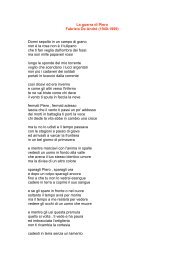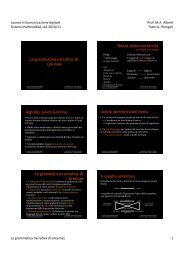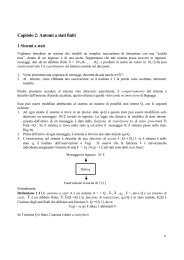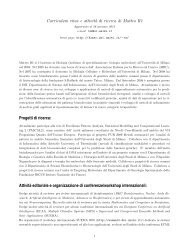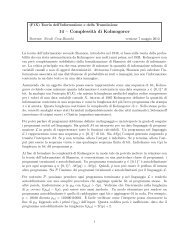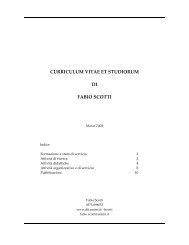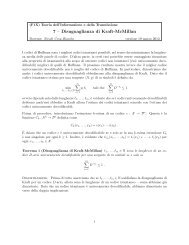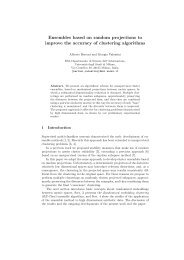- Page 1:
Il Linguaggio Fortran 90/95 Raucci
- Page 4 and 5:
1.9.3 Funzioni numeriche . . . . .
- Page 6 and 7:
5 Unità di Programma 217 5.1 Il pr
- Page 8 and 9:
8.3.2 I/O con meccanismo namelist .
- Page 10 and 11:
10 • Tipi di dati intrinseci non
- Page 12 and 13:
12 Tipi ed espressioni Quale che si
- Page 14 and 15:
14 Tipi ed espressioni Nella forma
- Page 16 and 17:
16 Tipi ed espressioni • Un nome
- Page 18 and 19:
18 Tipi ed espressioni eseguire il
- Page 20 and 21:
20 Tipi ed espressioni 1.3.1 Costan
- Page 22 and 23:
22 Tipi ed espressioni INTEGER [[([
- Page 24 and 25:
24 Tipi ed espressioni 1.3.5 Oggett
- Page 26 and 27:
26 Tipi ed espressioni Se una costa
- Page 28 and 29:
28 Tipi ed espressioni 1.5 Istruzio
- Page 30 and 31:
30 Tipi ed espressioni Dal momento
- Page 32 and 33:
32 Tipi ed espressioni 2. Vengono c
- Page 34 and 35:
34 Tipi ed espressioni 1/2 + 1./4.
- Page 36 and 37:
36 Tipi ed espressioni risultati im
- Page 38 and 39:
38 Tipi ed espressioni x × 2 x + x
- Page 40 and 41:
40 Tipi ed espressioni Si noti che
- Page 42 and 43:
42 Tipi ed espressioni Data attuale
- Page 44 and 45:
44 Tipi ed espressioni 1.5.3 Espres
- Page 46 and 47:
46 Tipi ed espressioni l_1 .NOT.l_1
- Page 48 and 49:
48 Tipi ed espressioni L’istruzio
- Page 50 and 51:
50 Tipi ed espressioni Se, ad esemp
- Page 52 and 53:
52 Tipi ed espressioni MODULE mymod
- Page 54 and 55:
54 Tipi ed espressioni Ancora una v
- Page 56 and 57:
56 Tipi ed espressioni dfdx_4 = (f2
- Page 58 and 59:
58 Tipi ed espressioni Se non è di
- Page 60 and 61:
60 Tipi ed espressioni ... END PROG
- Page 62 and 63:
62 Tipi ed espressioni risulta corr
- Page 64 and 65:
64 Tipi ed espressioni ! Definizion
- Page 66 and 67:
66 Tipi ed espressioni TYPE(isotopo
- Page 68 and 69:
68 Tipi ed espressioni istruzione S
- Page 70 and 71:
70 Tipi ed espressioni DBLE(A) Conv
- Page 72 and 73:
72 Tipi ed espressioni COS(X) Resti
- Page 74 and 75:
74 Tipi ed espressioni MAX(A1,A2[,A
- Page 76 and 77:
76 Tipi ed espressioni 1.9.4 Funzio
- Page 78 and 79:
78 Tipi ed espressioni FRACTION(X)
- Page 80 and 81:
80 Tipi ed espressioni SET_EXPONENT
- Page 82 and 83: 82 Tipi ed espressioni Base: 2 Rang
- Page 84 and 85: 84 Tipi ed espressioni IACHAR(C) Re
- Page 86 and 87: 86 Tipi ed espressioni l = LLE(’A
- Page 88 and 89: 88 Tipi ed espressioni
- Page 90 and 91: 90 Istruzioni di controllo 2.2 Istr
- Page 92 and 93: 92 Istruzioni di controllo READ(*,*
- Page 94 and 95: 94 Istruzioni di controllo d = b**2
- Page 96 and 97: 96 Istruzioni di controllo Una cosa
- Page 98 and 99: 98 Istruzioni di controllo che hann
- Page 100 and 101: 100 Istruzioni di controllo L’ist
- Page 102 and 103: 102 Istruzioni di controllo Tabelli
- Page 104 and 105: 104 Istruzioni di controllo esso de
- Page 106 and 107: 106 Istruzioni di controllo La vari
- Page 108 and 109: 108 Istruzioni di controllo Il segu
- Page 110 and 111: 110 Istruzioni di controllo ! IMPLI
- Page 112 and 113: 112 Istruzioni di controllo PRINT*,
- Page 114 and 115: 114 Istruzioni di controllo READ(*,
- Page 116 and 117: 116 Istruzioni di controllo Armstro
- Page 118 and 119: 118 Istruzioni di controllo DO i=1,
- Page 120 and 121: 120 Istruzioni di controllo realizz
- Page 122 and 123: 122 Istruzioni di controllo
- Page 124 and 125: 124 Array • Le modalità di acces
- Page 126 and 127: 126 Array E’ anche possibile defi
- Page 128 and 129: 128 Array 3.3.2 Costruttore di arra
- Page 130 and 131: 130 Array Inizializzazione attraver
- Page 134 and 135: 134 Array Come ulteriore esempio, s
- Page 136 and 137: 136 Array e tre variabili intere m,
- Page 138 and 139: 138 Array ! *** Sezione esecutiva *
- Page 140 and 141: 140 Array 3.8.1 Loop interchange I
- Page 142 and 143: 142 Array che è un valore di un or
- Page 144 and 145: 144 Array ! ciclo ottimizzato con l
- Page 146 and 147: 146 Array ! Sezione dichiarativa IM
- Page 148 and 149: 148 Array a(n-1) = a(n-1) + a(n-2)*
- Page 150 and 151: 150 Array stesso spazio di iterazio
- Page 152 and 153: 152 Array b(i+1) = b(i) + a(i) END
- Page 154 and 155: 154 Array b(i) = b(i)+b(2) END DO D
- Page 156 and 157: 156 Array I cicli così riscritti p
- Page 158 and 159: 158 Array cicli in quanto non sempr
- Page 160 and 161: 160 Array In questo caso la lista d
- Page 162 and 163: 162 Array con cui l’introduzione
- Page 164 and 165: 164 Array INTEGER :: numero_atomico
- Page 166 and 167: 166 Array in cui espressione_schema
- Page 168 and 169: 168 Array per far sì che una opera
- Page 170 and 171: 170 Array FORALL (i=1:n-1) FORALL (
- Page 172 and 173: 172 Array Così, ad esempio, con ri
- Page 174 and 175: 174 Array
- Page 176 and 177: 176 Operazioni di I/O interattive
- Page 178 and 179: 178 Operazioni di I/O interattive c
- Page 180 and 181: 180 Operazioni di I/O interattive i
- Page 182 and 183:
182 Operazioni di I/O interattive I
- Page 184 and 185:
184 Operazioni di I/O interattive d
- Page 186 and 187:
186 Operazioni di I/O interattive 4
- Page 188 and 189:
188 Operazioni di I/O interattive 4
- Page 190 and 191:
190 Operazioni di I/O interattive V
- Page 192 and 193:
192 Operazioni di I/O interattive L
- Page 194 and 195:
194 Operazioni di I/O interattive
- Page 196 and 197:
196 Operazioni di I/O interattive W
- Page 198 and 199:
198 Operazioni di I/O interattive v
- Page 200 and 201:
200 Operazioni di I/O interattive a
- Page 202 and 203:
202 Operazioni di I/O interattive h
- Page 204 and 205:
204 Operazioni di I/O interattive
- Page 206 and 207:
206 Operazioni di I/O interattive S
- Page 208 and 209:
208 Operazioni di I/O interattive 4
- Page 210 and 211:
210 Operazioni di I/O interattive &
- Page 212 and 213:
212 Operazioni di I/O interattive S
- Page 214 and 215:
214 Operazioni di I/O interattive R
- Page 216 and 217:
216 Operazioni di I/O interattive
- Page 218 and 219:
218 Unità di Programma [CONTAINS p
- Page 220 and 221:
220 Unità di Programma [prefisso]
- Page 222 and 223:
222 Unità di Programma FUNCTION li
- Page 224 and 225:
224 Unità di Programma PROGRAM mai
- Page 226 and 227:
226 Unità di Programma REAL FUNCTI
- Page 228 and 229:
228 Unità di Programma 5.5 Moduli
- Page 230 and 231:
230 Unità di Programma END MODULE
- Page 232 and 233:
232 Unità di Programma REAL(r8),PA
- Page 234 and 235:
234 Unità di Programma definite in
- Page 236 and 237:
236 Unità di Programma SEQUENCE IN
- Page 238 and 239:
238 Unità di Programma RETURN CONT
- Page 240 and 241:
240 Unità di Programma Nel seguent
- Page 242 and 243:
242 Unità di Programma - abbia un
- Page 244 and 245:
244 Unità di Programma FUNCTION f(
- Page 246 and 247:
246 Unità di Programma I nomi dei
- Page 248 and 249:
248 Unità di Programma In questo e
- Page 250 and 251:
250 Unità di Programma vengono pas
- Page 252 and 253:
252 Unità di Programma ma di solit
- Page 254 and 255:
254 Unità di Programma Un semplice
- Page 256 and 257:
256 Unità di Programma REAL :: one
- Page 258 and 259:
258 Unità di Programma CALL do_mat
- Page 260 and 261:
260 Unità di Programma INTEGER, IN
- Page 262 and 263:
262 Unità di Programma IMPLICIT NO
- Page 264 and 265:
264 Unità di Programma - Procedure
- Page 266 and 267:
266 Unità di Programma Differenza
- Page 268 and 269:
268 Unità di Programma Il seguente
- Page 270 and 271:
270 Unità di Programma Del program
- Page 272 and 273:
272 Unità di Programma Come esempi
- Page 274 and 275:
274 Unità di Programma IMPLICIT NO
- Page 276 and 277:
276 Unità di Programma ! INTEGER,
- Page 278 and 279:
278 Unità di Programma mnth = moun
- Page 280 and 281:
280 Unità di Programma n dischi pe
- Page 282 and 283:
282 Unità di Programma RECURSIVE S
- Page 284 and 285:
284 Unità di Programma IMPLICIT NO
- Page 286 and 287:
286 Unità di Programma SUBROUTINE
- Page 288 and 289:
288 Unità di Programma IF(s(i:i)==
- Page 290 and 291:
290 Unità di Programma 17.7999992
- Page 292 and 293:
292 Unità di Programma FUNCTION ve
- Page 294 and 295:
294 Unità di Programma definite. I
- Page 296 and 297:
296 Unità di Programma ==========
- Page 298 and 299:
298 Unità di Programma Per il calc
- Page 300 and 301:
300 Unità di Programma C:\MYPROG>p
- Page 302 and 303:
302 Unità di Programma matrix al f
- Page 304 and 305:
304 Unità di Programma Tutte le va
- Page 306 and 307:
306 Unità di Programma END FUNCTIO
- Page 308 and 309:
308 Unità di Programma FUNCTION f(
- Page 310 and 311:
310 Unità di Programma x = findRoo
- Page 312 and 313:
312 Unità di Programma
- Page 314 and 315:
314 Array Processing 6.2 Array di f
- Page 316 and 317:
316 Array Processing Tuttavia, se u
- Page 318 and 319:
318 Array Processing 6.5 Array allo
- Page 320 and 321:
320 Array Processing matrice quadra
- Page 322 and 323:
322 Array Processing INTEGER :: sta
- Page 324 and 325:
324 Array Processing In tal caso, l
- Page 326 and 327:
326 Array Processing CONTAINS SUBRO
- Page 328 and 329:
328 Array Processing ! Costruzione
- Page 330 and 331:
330 Array Processing ANY((/.FALSE.,
- Page 332 and 333:
332 Array Processing • L’array
- Page 334 and 335:
334 Array Processing • Se l’arg
- Page 336 and 337:
336 Array Processing L’argomento
- Page 338 and 339:
338 Array Processing dove il risult
- Page 340 and 341:
340 Array Processing ! *** Sezione
- Page 342 and 343:
342 Array Processing 0 8 0 0 0 0 7
- Page 344 and 345:
344 Array Processing FIELD deve ess
- Page 346 and 347:
346 Array Processing L’argomento
- Page 348 and 349:
348 Array Processing MAXLOC(mat,DIM
- Page 350 and 351:
350 Array Processing Esempi: Sia v
- Page 352 and 353:
352 Array Processing • Il valore
- Page 354 and 355:
354 Array Processing 6.6.7 Procedur
- Page 356 and 357:
356 Array Processing • Se MATRIX_
- Page 358 and 359:
358 Array Processing WRITE(*,*) " I
- Page 360 and 361:
360 Array Processing ELSE m(k,k:n+1
- Page 362 and 363:
362 Puntatori in cui: tipo, POINTER
- Page 364 and 365:
364 Puntatori nome_puntatore => nom
- Page 366 and 367:
366 Puntatori il cui nome è sul la
- Page 368 and 369:
368 Puntatori ... NULLIFY(pt1) ! pt
- Page 370 and 371:
370 Puntatori END TYPE matrix INTER
- Page 372 and 373:
372 Puntatori CALL setm(2,2,tmp(1:2
- Page 374 and 375:
374 Puntatori PRINT*, q ! ...stampa
- Page 376 and 377:
376 Puntatori END PROGRAM sort Si r
- Page 378 and 379:
378 Puntatori REAL,DIMENSION(10,10)
- Page 380 and 381:
380 Puntatori SUBROUTINE sub(p) REA
- Page 382 and 383:
382 Puntatori 7.9 Funzioni Puntator
- Page 384 and 385:
384 Puntatori INTEGER, POINTER :: p
- Page 386 and 387:
386 Puntatori value pointer Figura
- Page 388 and 389:
388 Puntatori Uno dei vantaggi che
- Page 390 and 391:
390 Puntatori search: DO IF ((ptr%v
- Page 392 and 393:
392 Puntatori MODULE linked_list US
- Page 394 and 395:
394 Puntatori PROGRAM main ! Scopo:
- Page 396 and 397:
396 Puntatori value pointer ❄ ❄
- Page 398 and 399:
398 Puntatori INTERFACE OPERATOR(==
- Page 400 and 401:
400 Puntatori RECURSIVE SUBROUTINE
- Page 402 and 403:
402 Puntatori operazioni di ricerca
- Page 404 and 405:
404 Puntatori END IF ! Stampa il co
- Page 406 and 407:
406 Puntatori equal_to = .TRUE. ELS
- Page 408 and 409:
408 Puntatori Reed Oliver 618-813-1
- Page 410 and 411:
410 Operazioni di I/O su file Un re
- Page 412 and 413:
412 Operazioni di I/O su file lista
- Page 414 and 415:
414 Operazioni di I/O su file • L
- Page 416 and 417:
416 Operazioni di I/O su file • L
- Page 418 and 419:
418 Operazioni di I/O su file • N
- Page 420 and 421:
420 Operazioni di I/O su file 1 L
- Page 422 and 423:
422 Operazioni di I/O su file invec
- Page 424 and 425:
424 Operazioni di I/O su file Chiar
- Page 426 and 427:
426 Operazioni di I/O su file ACTIO
- Page 428 and 429:
428 Operazioni di I/O su file EXIT
- Page 430 and 431:
430 Operazioni di I/O su file ! del
- Page 432 and 433:
432 Operazioni di I/O su file 8.3.1
- Page 434 and 435:
434 Operazioni di I/O su file NAMEL
- Page 436 and 437:
436 Operazioni di I/O su file • N
- Page 438 and 439:
438 Operazioni di I/O su file Al fi
- Page 440 and 441:
440 Operazioni di I/O su file 16/12
- Page 442 and 443:
442 Operazioni di I/O su file CHARA
- Page 444 and 445:
444 Insieme di codifica ASCII
- Page 446 and 447:
446 Precedenza degli operatori nel
- Page 448 and 449:
448 Ordinamento delle istruzioni Fo
- Page 450 and 451:
450 Applicabilità degli specificat
- Page 452 and 453:
452 Procedure intrinseche A Qualsia
- Page 454 and 455:
454 Procedure intrinseche Nome gene
- Page 456 and 457:
456 Procedure intrinseche Nome gene



![1) [4] Cos'è un hazard? Uno stallo? Cos'è una pipeline multiple ...](https://img.yumpu.com/16431383/1/190x245/1-4-cose-un-hazard-uno-stallo-cose-una-pipeline-multiple-.jpg?quality=85)
